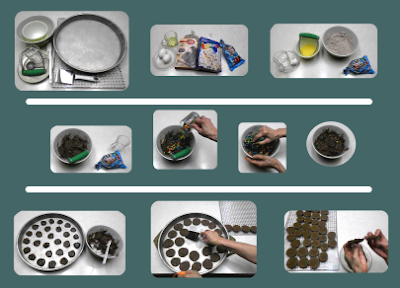Oops and aww (biggest snag): My camera battery ran out before I could finish recording all of pie #2 process.
My camera died about halfway through the lattice-cutting stage. My final video will be a composite of steps I took for making pie #2 and pie #3. It'll be a Frankenstein assemblage of video clips and edits—more clips of the better results and omission of some of the not-so-hot ones. The entire recipe will be in Episode 3 article.
Oops and ahh: I missed integrating the butter into the dry ingredients, but the crust came out fine anyway.
I had forgotten the step of slowly mixing the cut butter into the stirred dry ingredients (flour, salt, sugar) before adding water. (I'd interrupted my dough process to eat breakfast.) I put the bowl of butter and dry ingredients into the refrigerator, to resume the process afterward in about an hour.
After breakfast, I resumed the dough process. I trickled icy water into the slowly moving mixer, watching for dough texture to become acceptable. After turning out the dough onto my floured work surface, I pressed it, folded it towards me, pressed, folded, left-right, pressed, wrapped in plastic wrap, and refrigerated it.
When I realized I'd omitted the intermediate step, I compensated by refrigerating the mixed, plastic-wrapped dough for about three hours before rollout. (Numerous sites recommend at least one hour.)
Anyway, the missed step did not affect the outcome of the crust. Two possible actions that might have helped the crust results:
- Tossing the cut butter pieces through the dry ingredients, thus coarse-integrating the ingredients while coating the butter
- Refrigerating the bowlful of butter and dry ingredients for an hour during my leisurely breakfast, thus chilling the ingredients before further mixing
Oops: The fruit fluid was a bit thick for my pasta drainer to strain the cherries.
For the fruit-and-sugar-overnight process, I used my pasta drainer, similar to the "Stainless Steel Pot Drainer with Handle". The task was awkward. The holes were a bit undersized for draining the viscous fluid from the cherries. Also, holding the drainer against the bowl was somewhat unwieldy.
I decided to root around my kitchen gadgets for a more suitable straining device. Next pie, I'll try my fry basket, which resembles one from Lionsdeal. One possible workaround for easier draining is warming up the fruit mixture in the microwave until the fluid becomes runnier.
Oops: The length of the new Joseph adjustable rolling pin overspanned the existing cutting board that I used for dough rollout.
The cutting board I used was 13 inches wide. The roller (between the gauges) measures more than that, thus, making the roller's thickness wheel gauges ineffective. I've bought and will use a 16" x 16" plastic cutting board that will more than accommodate the roller.
Aww: My latticing skills still need work.
My pressing down of the rectangular cooling rack didn't help me with cutting lattice strips very straight. Next pie, I'll use a pizza cutter with cooling rack together to make the cuts. It'll be like using an X-Acto knife and a straightedge that has yoked multiple edges.
Ahh: My crust for pies #1 and #2 seemed tough as time passed, but dough treatment wasn't the reason.
The key is that refrigerated pie crust gets harder because of butter getting more solid when chilled. The day after the pie was in the refrigerator, I cut a piece and warmed it in the microwave. Eureka! Yummy pie with tender crust! The Other likes his pie cold, and my entreaties to warm his were soundly rejected. Anyway, if your cooled-down pie crust seems tough, warm it up.
Speaking of pie crust, I did some research on economics of DIY crust. Ingredients are cheaper for homemade, and you know all the items you're putting in. Prices are approximate, and YMMV for amounts, as humidity and measurement methods can differ.
For scratch crust ingredients, the most significant for cost are flour and butter. I'm excluding cost and weight for sugar and salt, as their bulk and cost impacts are negligible. Estimates:
flour (~ $2 for 5 pounds, estimation of 20-25 cents for 2 1/4 C flour)
butter (~$3.50 per pound, estimation of $1.30 for 3/8 pound)
Calculating about $1.50 for ~9 oz flour, 5 oz butter, 6 oz water and weight of about 1 1/4 pounds (20 oz).
For pre-made crusts:
- Pillsbury All Ready Rolled Pie Crust (2), refrigerated rolled up, 14.1 oz, ~$3
- Mrs. Smith's 9 Inch Flaky Homestyle Deep Dish Pie Shells (2), frozen, includes pie pans, 16 oz, ~$3
I baked the pie at 375° for 30 minutes, placed my pie shield on it, and baked it for another 30 minutes. Upon cutting it open three hours later, I felt that another 5 minutes baking might have browned the underside more without burning it.
Ahh: The fruit sauce held together well, barely pooling. By the last day, only a little of the sauce pooled. Incidentally, this pie lasted us only three days; pie #1 lasted four days.
One more incidental: This unbaked pie weighed 2 pounds, 15 ½ ounces with pan; pan weighs 2 ounces. The baked pie and pan (20 minutes after removal from oven and reweighed ~ 1 hour later) weighed 2 pounds, 14 ounces. Net weight loss through water vapor evaporation was 2 ½ ounces.
Visit "Cherry Pie, Episode 3--Using Frozen Cherries and Scratch Crust Ingredients", my assessment of cherry pie #3, which also includes links to YouTube video segments for making cherry pie.










